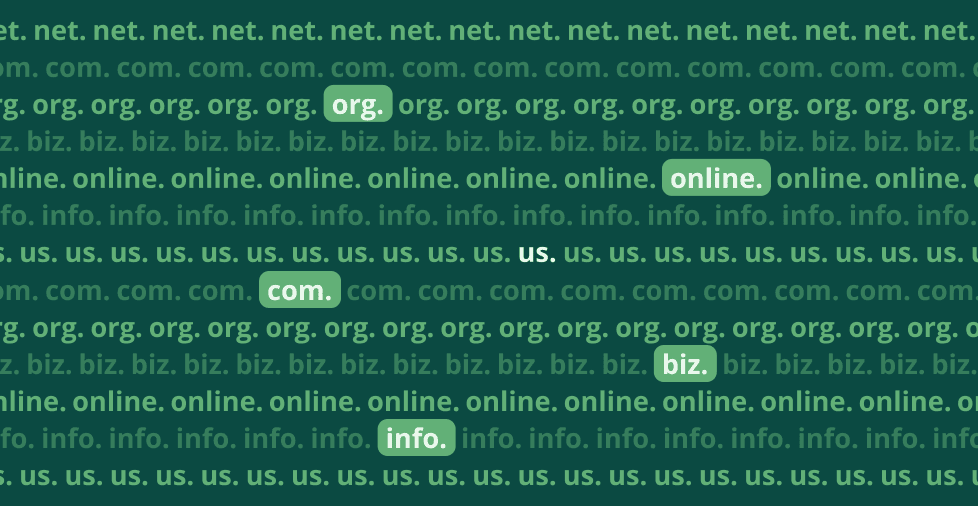Key takeaways:
- Domain names remain a critical digital asset, reflecting the ongoing expansion of the online economy.
- .com remains the dominant domain, with over 157.2 million registrations, followed by country-code domains (.cn, .de, .uk) and other popular gTLDs (.net, .org).
- The number of available domain extensions (TLDs) has expanded to over 1,500, including new gTLDs like .xyz and .app.
According to the Domain Name Industry Brief (DNIB), global domain name registrations reached approximately 371.7 million by the end of Q2 2025—an increase of 3.3 million (0.9%) from Q1 and 9.3 million (2.6%) year over year.
Understanding domain growth matters because domain names are the backbone of digital identity, SEO visibility, and brand credibility. As more businesses go online, knowing how domain registration trends are evolving can help you secure your brand’s place online.
How many domains are there in 2025?
The number of registered domains is constantly evolving. While the overall trend shows consistent growth, there can be periods of slight decline.
Global domain name registrations reached approximately 371.7 million by the end of Q2 2025. This represents a 1.7% increase, compared to the same period in 2024 according to a report by DNIB.
The domain name system is divided into several broad categories:
- Generic top-level domains (gTLDs). Widely recognized extensions like .com and .net, used globally for commercial and general purposes.
- Country-code top-level domains (ccTLDs). Two-letter domains representing specific countries or territories, such as .uk for the United Kingdom or .de for Germany.
- Other legacy gTLDs. Extensions that predate the new TLD program but aren’t as dominant as .com or .net, such as .org, .info, and .biz.
Each of these categories serves different purposes and has shown unique growth patterns in recent years.
Q1 2025 domain registration breakdown
At the close of the first quarter of 2025, the global domain name industry continued its steady growth:
- .com & .net: 169.8 million (with .com at 157.2 million and .net at 12.6 million), up 0.5% from Q4 2024 but down 1.5% year-over-year (DNIB).
- Country-code TLDs (ccTLDs): 142.9 million, up 1.5% from Q4 2024 and 2.4% year-over-year.
- New gTLDs (ngTLDs): 37.8 million, up 2.6% from Q4 and a strong 13.5% year-over-year.
- Other legacy gTLDs (excluding .com and .net): 17.9 million, up 2.0% from Q4 and 5% year-over-year.
Note: The information provided is based on data from the ‘Domain Name Industry Brief Quarterly Report’ for Q1 2025.
Factors behind the dynamic growth of domains
While the overall trend shows consistent growth in domain registration, there can be periods of slight decline.
A few things can cause these shifts:
- Launch of new top-level domains
- Shifts in the global economy
- Pace of new businesses and websites being created
At the end of the day, the continuous rise in registrations shows that the internet keeps expanding, and more businesses, individuals, and organizations want to carve out their own space online.
Most registered domain extensions
The days of just having .com, .org, and .net are over. A new wave of TLDs now offers smarter, more relevant ways to brand online.
Over 1,000 gTLDs are now included in the IANA root database, with new ones continuing to be introduced each year.
New options like .app, .store, and .tech make it easier to get a domain that fits your industry, feels relevant, and helps you stand out with a name people will actually remember.
The most registered TLDs by early 2025 were:
- .com
- .cn
- .de
- .net
- .org
- .uk
- .ru
- .nl
- .br
- .au

What is a domain name?
A domain name is your unique online address that makes it easy for people to find your website. Instead of having to remember a long string of numbers—an IP address like 192.0.2.1—you can simply type in a memorable name like networksolutions.com to go directly to a site.
A domain name is the core part of a Uniform Resource Locator (URL). The URL provides the full address, including the protocol and the specific page you’re visiting.
For example:
- Domain name: networksolutions.com
- Full URL: https://www.networksolutions.com/hosting
In this example, networksolutions.com is the domain name, while the full URL includes the protocol (https://), the subdomain (www.), and the specific page path (/hosting).
Choosing the right domain name is important. It’s the first thing your customers will see, so it should be simple, memorable, and directly related to your brand.
The anatomy of a domain name
Every domain name is built from several key parts that work together to help browsers locate a website. Once you understand how those parts fit, you’ll be better equipped to claim your online presence.
Here’s a quick breakdown of what makes up a domain name:
- Top-level domain (TLD). Also known as the domain extension, this is the part of the domain name that comes after the final dot, such as .com, .net, or .org. TLDs help categorize websites by purpose, industry, or geographic location. They can be generic, like .com, or country-specific like .ca.
- Second-level domain (SLD). This is the unique, customizable part of the domain name that appears before the TLD. The SLD is where you typically place your brand name, like “networksolutions” in networksolutions.com.
- Subdomain. A subdomain is an optional extension of your main domain, used to organize different sections of your website. It comes before the second-level domain. For example, in blog.networksolutions.com, “blog” is the subdomain. Using subdomains allows you to create separate sections for your content, like a blog or a support portal, without the need for a completely new domain name.
Why TLD choice matters
The choice of a top-level domain (TLD) is a strategic move that significantly influences your brand’s online identity. It affects trust, perception, and reach.
- SEO and trust. A ccTLD like .de or .uk can boost local search rankings and audience trust.
- Branding. A TLD like .ai signals tech/AI focus, while .app or .shop highlights purpose clarity.
- Supply strategy. Securing variations (.com, .net, and local ccTLDs) protects your brand and user reach.
Domain growth: Past, present, and future
With the domain space already rich in variety, the next wave of innovation is being shaped by emerging technologies.
AI is starting to influence how people choose domains, and blockchain is opening the way for decentralized domain names.
So how do you keep up and protect your brand online? Here are a few practical steps:
- Consider securing both global (e.g., .com, .app, .ai) and local ccTLDs to protect brand identity and tap market trust.
- Watch trends. ngTLDs are gaining traction in branding niches (e.g., .shop, .tech).
- Think about IDNs for multilingual audiences and accessibility.
How to choose the right domain name
The name you choose becomes the foundation of your online presence, so it’s worth taking the time to get it right. Here are some key points to guide your decision:
- Stay relevant. Your domain should represent who you are and what you do. Whether it’s for a business, brand, or personal project, it needs to instantly connect with your purpose.
- Keep it simple and memorable. Short, clear, and easy-to-pronounce names are more likely to stick in people’s minds. Steer clear of tricky spellings, hyphens, or numbers that can cause confusion.
- Protect your brand identity. A domain is an extension of your brand. Make sure it fits seamlessly with your logo, messaging, and overall identity. Consistency helps build trust and recognition.
- Think about keywords. When it makes sense, include keywords that reflect your industry or services. This can give your website a little extra boost in search engine visibility.
- Pick the right extension. From classic options like .com to niche choices like .tech or country-specific endings, your domain extension should match your audience and goals. Global reach? Stick with a gTLD. Local presence? A ccTLD might be perfect.
Whatever name you decide on, be sure to register it with a reliable domain registrar so you can secure your online identity with confidence.

Secure your domain, build your brand
Domain registrations are steadily climbing. Legacy gTLDs like .com are still on top, but ccTLDs and new gTLDs are growing fast. AI-related domains like .ai and internationalized domains (IDNs) are also offering fresh opportunities for branding and inclusivity.
All of this points to one truth: the internet is only getting bigger, and with it, the demand for good domain names. The longer you wait, the harder it gets to find the perfect fit.
Don’t wait until someone else grabs the domain name you want. Register yours today with Network Solutions and take the first step toward growing your online presence!
Frequently asked questions
Registering a domain means you’re “renting” the rights to use it for a set period (usually 1–10 years). It’s like renting your spot on the internet.
You’re considered the owner as long as you keep renewing it. But if you let it expire, someone else can take it. So technically, you don’t own it forever. You just hold the rights to it for as long as you stay on top of renewals.
Here are the different types of top-level domains (TLDs):
-Generic top-level domains (gTLD)
-Sponsored top-level domains (sTLD)
-Country code top-level domains (ccTLD)
-Infrastructure top-level domain (ARPA)
-Test top-level domains (tTLD)
A domain registrar is a company authorized by the the Internet Corporation for Assigned Names and Numbers (ICANN) to sell and manage domain names.
When you register a domain, you’re doing it through a registrar. They handle the paperwork, make sure your domain is listed properly, and often offer extras like email, website hosting, and auto-renew options.
The United States has the highest number of registered domain names globally, with around 142 million domains. This includes a mix of popular extensions like .com, .us, and newer options such as .app and .ai.
Following behind the U.S. are Iceland, China, and Canada.
Not exactly. When you buy a domain, you’re actually registering it for a set period, usually one year. You can keep renewing it every year (or for multiple years at a time), and as long as you do, the domain stays yours.




